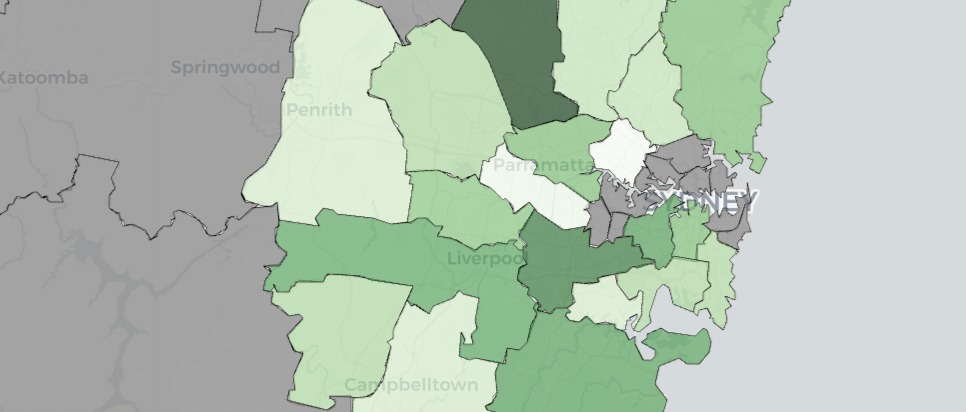Following up on Monday’s blog post, I’ve also added information about whether each candidate is an incumbent councillor to my dataset of 1402 candidates running for the 24 most populous councils.
I had noticed some councils where large numbers of sitting councillors were retiring. So I thought it’d be interesting to calculate rates of retirement for each council. For this post I’m including the incumbent mayor, and including the mayoral contest.
I’ll explain how I calculated the “retirement rate”, and some interesting wrinkles, at the end of this post, but here’s the map:
One council stands out above all others: The Hills. The Liberal Party has undergone a massive purge of their councillors, clearing out a majority including the current mayor. The Liberal Party currently holds ten seats on the council, alongside two Labor. The numbers were three Labor and ten Liberal in 2017, but Labor lost a seat to resignation in 2018 and the by-election was won by the Liberal Party. The Libs then lost a member in 2021 when a member subsequently elected to state parliament resigned. Both the ALP members are running again, but only three out of the ten Liberal members.
A majority of councillors is also retiring on Canterbury-Bankstown. Just five out of nine Labor councillors are running, but the rate is even worse amongst the other parties. Only two out of five Liberals are running, and the sole Greens member is retiring.
There’s a few others with relatively high rates. Just eight out of fifteen are running in Sutherland and Inner West (46.5% retirement rate), and 6 out of 11 are running in Liverpool, while 40% are retiring in Parramatta, the City of Sydney and the Northern Beaches.
On the other hand, Ryde has the lowest retirement rate. Just two out of twelve councillors are stepping down (16.7%). The rate is 20% in Cumberland, Hornsby and Penrith. If you thought that the high rate of retirement could reflect a nasty local council pushing councillors away, Cumberland will disprove that notion.
That’s it for now, but I will explain how I made some of the decisions about who is “retiring” below.
One of the things that complicated matters was councillors running for obviously unwinnable positions. Four out of five Greens councillors in the Inner West are retiring in practice, but two of those four retiring councillors are running in third on their party’s ticket. Obviously they won’t win, but they are still on the list. I identified nine councillors in such a position: two Greens in the Inner West, two Your Northern Beaches councillors and one councillor each in Ku-ring-gai, Lake Macquarie, Shoalhaven, Hornsby and the City of Sydney. I’m not counting them as “running”.
The case in Hornsby is particularly interesting. Sitting Greens councillor Joe Nicita had been announced as retiring, but is actually running in second place on independent councillor Vince Del Gallago in a neighbouring ward, against his fellow incumbent Greens councillor.
There were other cases that you could argue. The recently-ousted Liberal mayor of Parramatta, Bob Dwyer is running second on his ticket, but in a ward where the Liberal Party won two seats in 2017. I don’t think it’s implausible that he could win. The ALP has eight sitting councillors in Campbelltown and they are all running again. The person in eighth place will almost certainly not win, but I don’t think he is unserious in running for re-election. They count as running.
Finally, I haven’t really factored in vacancies. There are at least five in the 24 councils I’m analysing. In Blacktown, The Hills and Camden a councillor has resigned after winning a state seat. The “get Clover” legislation of 2012 banned state MPs from running for local council or for sitting on a council for more than two years after winning a state seat, while still allowing councillors to run for state parliament without immediately resigning. In theory this would allow councillors to serve out their term and retire at the council election, which is usually due 18 months after a state election. But this doesn’t consider by-elections (as in Blacktown) or a 15-month delay in the council elections.
There are also two vacancies caused by death – in Parramatta and Wollongong. I have included all five of these vacancies in the calculations so they are considered “retirements” – fair enough in the former, perhaps not in the latter, but it gives a sense of turnover.
This is my last blog post on the topic of nominations. Hopefully by the time this is published I’ve finished updating all of the guides with the final candidate lists.



